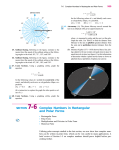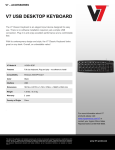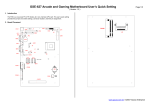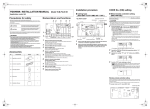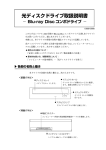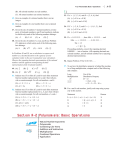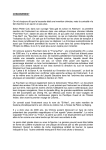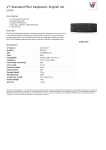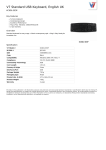Download Section 7-6 Complex Numbers in Rectangular and Polar Forms
Transcript
7-6 Complex Numbers in Rectangular and Polar Forms 65. Sailboat Racing. Referring to the figure, estimate to the nearest knot the speed of the sailboat sailing at the following angles to the wind: 30°, 75°, 135°, and 180°. 66. Sailboat Racing. Referring to the figure, estimate to the nearest knot the speed of the sailboat sailing at the following angles to the wind: 45°, 90°, 120°, and 150°. 67. Conic Sections. Using a graphing utility, graph the equation r⫽ 8 1 ⫺ e cos for the following values of e (called the eccentricity of the conic) and identify each curve as a hyperbola, an ellipse, or a parabola. (A) e ⫽ 0.4 (B) e ⫽ 1 r⫽ 553 3.442 ⫻ 107 1 ⫺ 0.206 cos where r is measured in miles and the sun is at the pole. Graph the orbit. Use TRACE to find the distance from Mercury to the sun at aphelion (greatest distance from the sun) and at perihelion (shortest distance from the sun). (B) Johannes Kepler (1571–1630) showed that a line joining a planet to the sun sweeps out equal areas in space in equal intervals in time (see the figure). Use this information to determine whether a planet travels faster or slower at aphelion than at perihelion. Explain your answer. (C) e ⫽ 1.6 (It is instructive to explore the graph for other positive values of e.) 68. Conic Sections. Using a graphing utility, graph the equation r⫽ 8 1 ⫺ e cos for the following values of e and identify each curve as a hyperbola, an ellipse, or a parabola. (A) e ⫽ 0.6 ★ (B) e ⫽ 1 (C) e ⫽ 2 69. Astronomy. (A) The planet Mercury travels around the sun in an elliptical orbit given approximately by Section 7-6 Complex Numbers in Rectangular and Polar Forms Rectangular Form Polar Form Multiplication and Division in Polar Form Historical Note Utilizing polar concepts studied in the last two sections, we now show how complex numbers can be written in polar form, which can be very useful in many applications. A brief review of Section 2-4 on complex numbers should prove helpful before proceeding further. Rectangular Form Recall from Section 2-4 that a complex number is any number that can be written in the form a ⫹ bi 554 7 ADDITIONAL TOPICS IN TRIGONOMETRY FIGURE 1 Complex plane. where a and b are real numbers and i is the imaginary unit. Thus, associated with each complex number a ⫹ bi is a unique ordered pair of real numbers (a, b), and vice versa. For example, 3 ⫺ 5i corresponds to (3, ⫺5) Associating these ordered pairs of real numbers with points in a rectangular coordinate system, we obtain a complex plane (see Fig. 1). When complex numbers are associated with points in a rectangular coordinate system, we refer to the x axis as the real axis and the y axis as the imaginary axis. The complex number a ⫹ bi is said to be in rectangular form. EXAMPLE 1 Plotting in the Complex Plane Plot the following complex numbers in a complex plane: A ⫽ 2 ⫹ 3i B ⫽ ⫺3 ⫹ 5i C ⫽ ⫺4 D ⫽ ⫺3i Solution MATCHED PROBLEM 1 1 Plot the following complex numbers in a complex plane: A ⫽ 4 ⫹ 2i B ⫽ 2 ⫺ 3i C ⫽ ⫺5 D ⫽ 4i On a real number line there is a one-to-one correspondence between the set of real numbers and the set of points on the line: each real number is associated with exactly one point on the line and each point on the line is associated with exactly one real number. Does such a correspondence exist between the set of complex numbers and the set of points in an extended plane? Explain how a one-to-one correspondence can be established. Polar Form Complex numbers also can be written in polar form. Using the polar–rectangular relationships from Section 7-5, x ⫽ r cos and y ⫽ r sin 7-6 Complex Numbers in Rectangular and Polar Forms 555 we can write the complex number z ⫽ x ⫹ iy in polar form as follows: FIGURE 2 Rectangular–polar relationship. z ⫽ x ⫹ iy ⫽ r cos ⫹ ir sin ⫽ r(cos ⫹ i sin ) (1) This rectangular–polar relationship is illustrated in Figure 2. In a more advanced treatment of the subject, the following famous equation is established: e i ⴝ cos ⴙ i sin (2) where ei obeys all the basic laws of exponents. Thus, equation (1) takes on the form z ⴝ x ⴙ yi ⴝ r(cos ⴙ i sin ) ⴝ rei FIGURE 3 (1 ⫹ i) ⫽ 1.41e 0.79i . (3) We will freely use rei as a polar form for a complex number. In fact, some graphing calculators display the polar form of x ⫹ iy this way (see Fig. 3 where is in radians and numbers are displayed to two decimal places). Since cos and sin are both periodic with period 2, we have cos( ⫹ 2k) ⫽ cos sin( ⫹ 2k) ⫽ sin k any integer Thus, we can write a more general polar form for a complex number z ⫽ x ⫹ iy, as given below, and observe that rei is periodic with period 2k, k any integer. GENERAL POLAR FORM OF A COMPLEX NUMBER For k any integer 1 z ⫽ x ⫹ iy ⫽ r[cos ( ⫹ 2k) ⫹ i sin ( ⫹ 2k)] z ⫽ rei(⫹2k) The number r is called the modulus, or absolute value, of z and is denoted by mod z or z . The polar angle that the line joining z to the origin makes with the polar axis is called the argument of z and is denoted by arg z. From Figure 2 we see the following relationships: ⱍⱍ MODULUS AND ARGUMENT FOR z ⴝ x ⴙ iy 2 mod z ⫽ r ⫽ 兹x2 ⫹ y2 arg z ⫽ ⫹ 2k Never negative k any integer where sin ⫽ y/r and cos ⫽ x/r. The argument is usually chosen so that ⫺180° ⬍ ⱕ 180° or ⫺ ⬍ ⱕ . 556 7 ADDITIONAL TOPICS IN TRIGONOMETRY EXAMPLE 2 Solutions FIGURE 4 From Rectangular to Polar Form Write parts A–C in polar form, in radians, ⫺ ⬍ ⱕ . Compute the modulus and arguments for parts A and B exactly; compute the modulus and argument for part C to two decimal places. (B) z2 ⫽ ⫺ 兹3 ⫹ i (C) z ⫽ ⫺5 ⫺ 2i (A) z1 ⫽ 1 ⫺ i Locate in a complex plane first; then if x and y are associated with special angles, r and can often be determined by inspection. (A) A sketch shows that z1 is associated with a special 45° triangle (Fig. 4). Thus, by inspection, r ⫽ 兹2, ⫽ ⫺/4 (not 7/4), and z1 ⫽ 兹2[cos (⫺/4) ⫹ i sin (⫺/4)] ⫽ 兹2 e(⫺/4)i (B) A sketch shows that z2 is associated with a special 30°–60° triangle (Fig. 5). Thus by inspection, r ⫽ 2, ⫽ 5/6, and FIGURE 5 z2 ⫽ 2(cos 5/6 ⫹ i sin 5/6) ⫽ 2e(5/6)i (C) A sketch shows that z3 is not associated with a special triangle (Fig. 6). So, we proceed as follows: r ⫽ 兹(⫺5)2 ⫹ (⫺2)2 ⫽ 5.39 ⫽ ⫺ ⫹ tan FIGURE 6 ⫺1 (25兲 ⫽ ⫺2.76 To two decimal places To two decimal places Thus, z3 ⫽ 5.39[cos (⫺2.76) ⫹ i sin (⫺2.76)] ⫽ 5.39e(⫺2.76)i To two decimal places Figure 7 shows the same conversion done by a graphing calculator with a builtin conversion routine (with numbers displayed to two decimal places). FIGURE 7 (⫺5 ⫺ 2i) ⫽ 5.39e(⫺2.76)i. MATCHED PROBLEM 2 Write parts A–C in polar form, in radians, ⫺ ⬍ ⱕ . Compute the modulus and arguments for parts A and B exactly; compute the modulus and argument for part C to two decimal places. (A) ⫺1 ⫹ i (B) 1 ⫹ i兹3 (C) ⫺3 ⫺ 7i 7-6 Complex Numbers in Rectangular and Polar Forms EXAMPLE 3 Solutions 557 From Polar to Rectangular Form Write parts A–C in rectangular form. Compute the exact values for parts A and B; for part C, compute a and b for a ⫹ bi to two decimal places. (B) z2 ⫽ 3e(⫺60°)i (C) z3 ⫽ 7.19e(⫺2.13)i (A) z1 ⫽ 2e(5/6)i (A) x ⫹ iy ⫽ 2e(5/6)i ⫽ 2[cos (5/6) ⫹ i sin (5/6)] 冢 ⫽2 冣 冢冣 ⫺ 兹3 1 ⫹ i2 2 2 ⫽ ⫺ 兹3 ⫹ i (B) x ⫹ iy ⫽ 3e(⫺60°)i ⫽ 3[cos (⫺60°) ⫹ i sin (⫺60°)] 冢12 冣 ⫹ i3冢⫺兹2 3 冣 ⫽3 ⫽ 3 3兹3 ⫺ i 2 2 FIGURE 8 7.19e(⫺2.13)i ⫽ ⫺3.81 ⫺ 6.09 i. (C) x ⫹ iy ⫽ 7.19e(⫺2.13)i ⫽ 7.19[cos (⫺2.13) ⫹ i sin (⫺2.13)] ⫽ ⫺3.81 ⫺ 6.09 i Figure 8 shows the same conversion done by a graphing calculator with a built-in conversion routine. 2 MATCHED PROBLEM 3 If your calculator has a built-in polar-to-rectangular conversion routine, try it on 兹2e45°i and 兹2e(/4)i, then reverse the process to see if you get back where you started. (For complex numbers in exponential polar form, some calculators require to be in radian mode for calculations. Check your user’s manual.) Write parts A–C in rectangular form. Compute the exact values for parts A and B; for part C compute a and b for a ⫹ bi to two decimal places. (A) z1 ⫽ 兹2e(⫺/2)i (B) z2 ⫽ 3e120°i (C) z3 ⫽ 6.49e(⫺2.08)i 558 7 ADDITIONAL TOPICS IN TRIGONOMETRY 3 Let z1 ⫽ 兹3 ⫹ i and z2 ⫽ 1 ⫹ i兹3. (A) Find z1z2 and z1/z2 using the rectangular forms of z1 and z2. (B) Find z1z2 and z1/z2 using the exponential polar forms of z1 and z2, in degrees. (Assume the product and quotient exponent laws hold for ei.) (C) Convert the results from part B back to rectangular form and compare with the results in part A. Multiplication and Division in Polar Form There is a particular advantage in representing complex numbers in polar form: multiplication and division become very easy. Theorem 1 provides the reason. (The exponential polar form of a complex number obeys the product and quotient rules for exponents: bmbn ⫽ bm⫹n and bm/bn ⫽ bm⫺n.) PRODUCTS AND QUOTIENTS IN POLAR FORM If z1 ⫽ r1ei and z2 ⫽ r2ei , then 1. z1z2 ⫽ r1ei r2ei ⫽ r1r2ei( ⫹ ) r1 z1 r1ei ⫽ ⫽ ei( ⫺ ) 2. z2 r2ei r2 1 1 2 1 2 1 2 1 1 2 2 We establish the multiplication property and leave the quotient property for Problem 32 in Exercise 7-6. z1z2 ⫽ r1ei r2ei 1 2 ⫽ r1r2(cos 1 ⫹ i sin 1)(cos 2 ⫹ i sin 2) Write in trigonometric form. Multiply. ⫽ r1r2(cos 1 cos 2 ⫹ i cos 1 sin 2 ⫹ i sin 1 cos 2 ⫺ sin 1 sin 2) ⫽ r1r2[(cos 1 cos 2 ⫺ sin 1 sin 2) ⫹ i(cos 1 sin 2 ⫹ sin 1 cos 2)] Use sum identities. ⫽ r1r2[cos (1 ⫹ 2) ⫹ i sin (1 ⫹ 2)] Write in exponential form. ⫽ r1r2ei( ⫹ ) 1 EXAMPLE 4 Solutions 2 Products and Quotients If z1 ⫽ 8e45°i and z2 ⫽ 2e30°i, find (B) z1/z2 (A) z1z2 (A) z1z2 ⫽ 8e45°i ⴢ 2e30°i ⫽ 8 ⴢ 2ei(45°⫹30°) ⫽ 16e75°i 7-6 Complex Numbers in Rectangular and Polar Forms (B) 559 z1 8e45°i ⫽ z2 2e30°i ⫽ 82ei(45°⫺30°) = 4e15°i MATCHED PROBLEM 4 If z1 ⫽ 9e165°i and z2 ⫽ 3e55°i, find (A) z1z2 (B) z1/z2 Historical Note There is hardly an area in mathematics that does not have some imprint of the famous Swiss mathematician Leonhard Euler (1707–1783), who spent most of his productive life at the New St. Petersburg Academy in Russia and the Prussian Academy in Berlin. One of the most prolific writers in the history of the subject, he is credited with making the following familiar notations standard: f(x) function notation e natural logarithmic base i imaginary unit, 兹⫺1 For our immediate interest, he is also responsible for the extraordinary relationship ei ⫽ cos ⫹ i sin If we let ⫽ , we obtain an equation that relates five of the most important numbers in the history of mathematics: ei ⫹ 1 ⫽ 0 Answers to Matched Problems 1. 2. (A) 兹2[cos (3/4) ⫹ i sin (3/4)] ⫽ 兹2e(3/4)i (B) 2[cos (/3) ⫹ i sin (/3)] ⫽ 2e(/3)i (⫺2.11)i (C) 5.83[cos (⫺2.11) ⫹ i sin (⫺2.11)] ⫽ 5.83e 3 3兹3 3. (A) ⫺i兹2 (B) ⫺ ⫹ i (C) ⫺3.16 ⫺ 5.67i 2 2 4. (A) z1z2 ⫽ 27e220°i (B) z1/z2 ⫽ 3e110°i 560 7 ADDITIONAL TOPICS IN TRIGONOMETRY 21. z1 ⫽ 3.05e1.76i, z2 ⫽ 11.94e2.59i EXERCISE 7-6 22. z1 ⫽ 7.11e0.79i, z2 ⫽ 2.66e1.07i A In Problems 1–8, plot each set of complex numbers in a complex plane. 1. A ⫽ 3 ⫹ 4i, B ⫽ ⫺2 ⫺ i, C ⫽ 2i 23. (⫺1 ⫹ i)2 2. A ⫽ 4 ⫹ i, B ⫽ ⫺3 ⫹ 2i, C ⫽ ⫺3i 24. (1 ⫹ i)2 3. A ⫽ 3 ⫺ 3i, B ⫽ 4, C ⫽ ⫺2 ⫹ 3i 25. (⫺1 ⫹ i)(1 ⫹ i) 4. A ⫽ ⫺3, B ⫽ ⫺2 ⫺ i, C ⫽ 4 ⫹ 4i 26. (1 ⫹ i兹3)(兹3 ⫹ i) 5. A ⫽ 2e(/3)i, B ⫽ 兹2e(/4)i, C ⫽ 4e(/2)i 6. A ⫽ 2e (/6)i 27. (1 ⫺ i)3 , B ⫽ 4e , C ⫽ 兹2e i (3/4)i , B ⫽ 3e 7. A ⫽ 4e (⫺150°)i 28. (1 ⫹ i)3 , C ⫽ 5e 20°i Simplify Problems 23–26 directly and by using polar forms. Write answers in both rectangular and polar forms ( is in degrees). (⫺90°)i 8. A ⫽ 2e150°i, B ⫽ 3e(⫺50°)i, C ⫽ 4e75°i C B 29. Show that r1/3e(/3)i is a cube root of rei. In Problems 9–12, change parts A–C to polar form. For Problems 9 and 10, choose in degrees, ⫺180° ⬍ ⱕ 180°; for Problems 11 and 12 choose in radians, ⫺ ⬍ ⱕ . Compute the modulus and arguments for parts A and B exactly; compute the modulus and argument for part C to two decimal places. 30. Show that r1/2e(/2)i is a square root of rei. 31. If z ⫽ rei, show that z2 ⫽ r2e2i and z3 ⫽ r3e3i. What do you think zn will be for n a natural number? 32. Prove z1 r1ei r1 ⫽ ⫽ ei( ⫺ ) z2 r2ei r2 1 1 (B) ⫺1 ⫺ i 9. (A) 兹3 ⫹ i 10. (A) ⫺1 ⫹ i兹3 (C) 5 ⫺ 6i (B) ⫺3i (C) ⫺7 ⫺ 4i 11. (A) ⫺ i兹3 (B) ⫺兹3 ⫺ i (C) ⫺8 ⫹ 5i 12. (A) 兹3 ⫺ i (B) ⫺2 ⫹ 2i (C) 6 ⫺ 5i In Problems 13–16, change parts A–C to rectangular form. Compute the exact values for parts A and B; for part C compute a and b for a ⫹ bi to two decimal places. 13. (A) 2e(/3)i (B) 兹2e(⫺45°)i 14. (A) 2e30°i (B) 兹2e(⫺3/4)i 15. (A) 6e(/6)i (B) 兹7e(⫺90°)i 16. (A) 兹3e (⫺/2)i (B) 兹2e 135°i 2 2 (C) 3.08e2.44i (C) 5.71e(⫺0.48)i (C) 4.09e(⫺122.88°)i (⫺108.82°)i (C) 6.83e In Problems 17–22, find z1z2 and z1 /z2. 17. z1 ⫽ 7e82°i, z2 ⫽ 2e31°i 18. z1 ⫽ 6e132°i, z2 ⫽ 3e93°i 19. z1 ⫽ 5e52°i, z2 ⫽ 2e83°i 20. z1 ⫽ 3e67°i, z2 ⫽ 2e97°i APPLICATIONS 33. Forces and Complex Numbers. An object is located at the pole, and two forces u and v act on the object. Let the forces be vectors going from the pole to the complex numbers 20e0°i and 10e60°i, respectively. Force u has a magnitude of 20 pounds in a direction of 0°. Force v has a magnitude of 10 pounds in a direction of 60°. (A) Convert the polar forms of these complex numbers to rectangular form and add. (B) Convert the sum from part A back to polar form. (C) The vector going from the pole to the complex number in part B is the resultant of the two original forces. What is its magnitude and direction? 34. Forces and Complex Numbers. Repeat Problem 33 with forces u and v associated with the complex numbers 8e0°i and 6e30°i, respectively.








